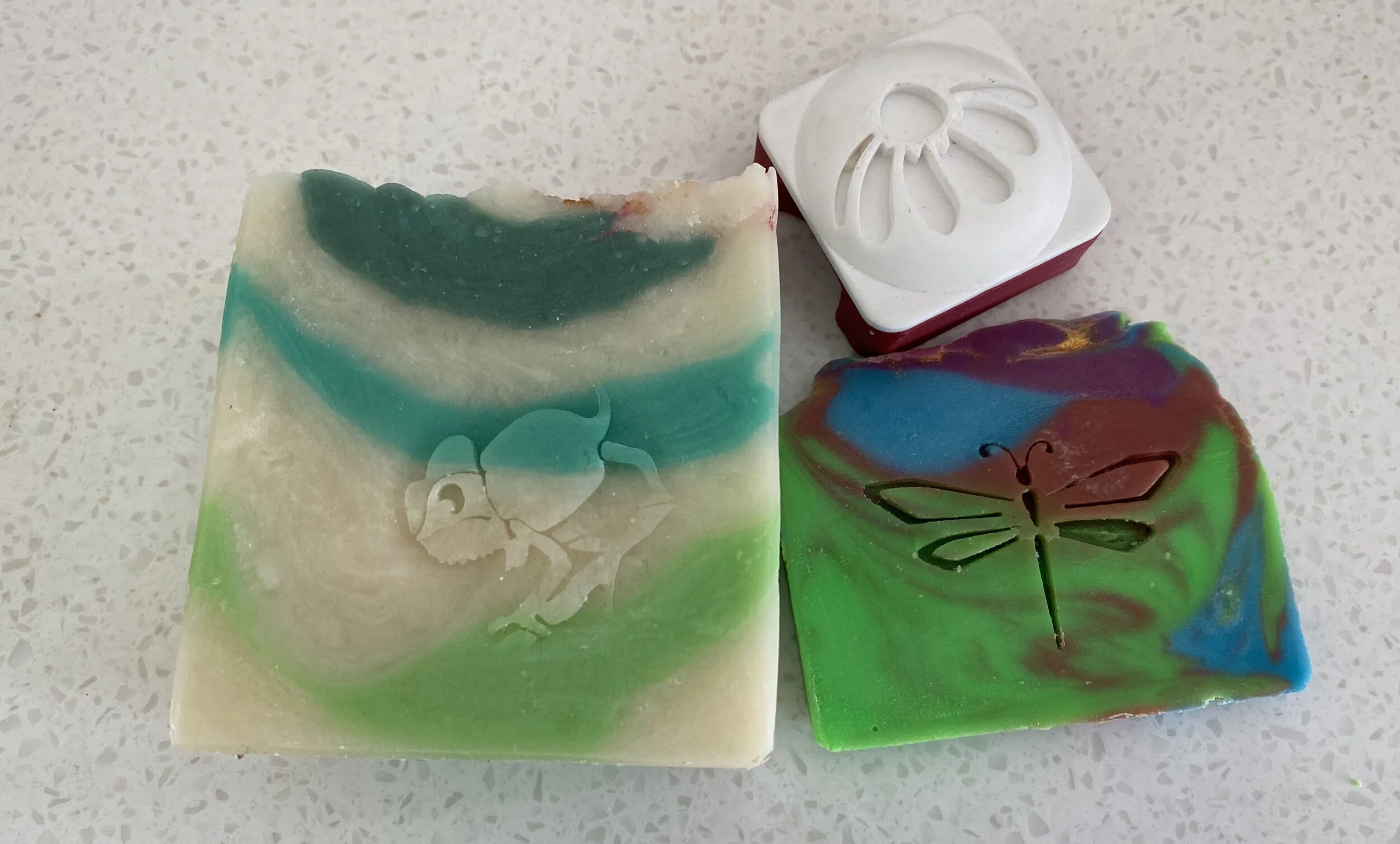Stamping soaps
There isn't a one-size-fits-all right way to stamp soap.
Getting your stamps to look perfect, with precise edges and perfect definition takes a bit of trial and error - and, dare I say it, time and practice.
Stamps work best on plain soaps which allows them to stand out and can add a professional pop to a simple soap.
Heike Koester from SoundSoap says, "You can use stamps to rescue a soap that didn't turn out as well as you hoped. You can pep it up with gold mica or other colours - spray the stamp surface with alcohol, dip into mica and stamp. When I get too much mica on the soap, I wash it off with a soft cloth - first with a bit of water, then clean it again with alcohol."
The best time to stamp
The best time to stamp your soap will depend on a few factors, including your percentage of hard and soft oils, your water discount, the temperature you soap at, the use of sodium lactate or salt, and the processes you might use such as Hot Process (HP) or Cold Process Oven Process (CPOP) in addition to how or where you cure your soaps.
As a rough rule of thumb, anything that makes your soap harden faster (like a high percentage of hard oils) will mean that you need to stamp earlier than average, while anything that makes your soap softer (not using a water discount or sodium lactate) will mean waiting a little longer to test your stamp.
The right timing can also depend on your stamp. Stamps with thin, clear lines are more forgiving and easier to work with than stamps with chunky patters and complex designs - so it's best to build up to what could be considered more advanced stamps.
Timing will also depend on whether you prefer to press your stamp by hand (earlier) or with a rubber hammer where a slightly harder soap works better.
If your soap is too soft to stamp the soap will stick in the stamp, and you won't have a clean design - or worst case, a smoosh that you need to plane off.
If your soap is too hard to stamp it cracks and breaks, but sometimes the rubber mallet works better than hand pressing around this point.
As a general guideline, your soap will be ready to stamp around one to two weeks, or up to three weeks, after the cut. If your soap surface feels soft or tacky, it will be too soon to stamp. Use your soap ends to test your stamps to get a feeling for the timing for your recipe.
I personally CPOP* my CP soaps (high hard oil content and water at 27%) and my optimal stamping period for hand stamping is a day or two after the cut. For HP with 38% water I get the best results at around one week.
*(as a generalization CPOP does make it more difficult to stamp your soaps).
These are some of my stamps from Soap Stamps 4 You. The 3D chameleon was stamped on hot process bars hoping for a subtle camouflage look. The 2D butterfly was tested on an end piece - it was still little bit too soft, and the 3D chamomile flower or daisy is one of my favourite stamps.
Stamping Tips
Soap ends are your friend. Always test your stamp on an endpiece first.
A light spray of isopropyl alcohol onto the stamp before you use it will help prevent soft soap from sticking to the stamp and ruining the sharpness of the design.
Some people wrap their stamp with cling wrap to stop the soap sticking. In my experience, this only works with certain stamp designs.
You can mica stamp your soaps at any time by lightly touching the surface of a mica-and-alcohol covered stamp to your soap. This won't work with 3D stamps but is an option if you're super impatient or have waited too long to stamp your soap.
Keep notes! Each recipe and process makes a difference. To get perfect stamp results, you either have to find what works and stick to it or keep records to help you remember.
Clean your stamp between each use and apply a new spritz of isopropyl alcohol.
Experiment to find the right pressure. Too soft and your stamp will not stand out well unless you’ve used mica as a highlight. Too hard and you will have an ugly and unwanted outline of the stamp edge impressed into your soap.
Heike is from SoundSoap in the beautiful Kenepuru Sound in New Zealand.
This article was written by Shaz, with input from Heike for additional perspective, for the January 2020 NZSMA Newsletter. Find out more about the New Zealand Soap Makers’ Association here.

